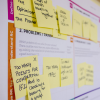For a digital design agency, client briefs are critical to our work. But sometimes, getting clients’ ideas out of their heads is not as easy as filling up a form or chatting for hours – conversations get misunderstood and writings get misinterpreted. At times, our questions in the brief can’t capture all the ideas while clients struggle to put their ideas in writing.
What’s a better solution? A show and tell session.
Yes, this old-as-time activity used in schools and loved by kids has helped us numerous times to really understand what the client wants visually.
And this simple show and tell concept has been developed further into what is called the Lightning Demo, under the Google Design Sprint methodology.
What is the Lightning Demo?
The Lightning Demo is a structured show and tell session, where we get clients to show their visual inspirations and examples of what they love.
We mainly use this technique as part of our Design Sprints, but we may utilise it during client or internal meetings to easily gather visual inputs. You can use it for pretty much any type of visual projects such as logo design, website design, product design, and marketing collateral designs such as advertisements, brochures and posters.
How does the Lightning Demo work?
Generally, the people needed are:
- 1 facilitator who will host the session, facilitate, take notes and make sure things don’t go off tangent.
- Participants or stakeholders in the project. I usually like to stick to the 2-pizza rule by Jeff Bezos. Things can get out of hand the more people you have in a session, so it’s best to cap it to 8 participants, and no fewer than 4, who will “show and tell” what they want.
To illustrate the process, I will use an example of building an eCommerce homepage for our Lightning Demo session. This is roughly how it goes:
- Before the demo, all the participants must research for several examples of other eCommerce homepages that they love. It could be from any industry, in fact, taking examples from outside your client’s industry may generate better ideas. The important thing is that each example should encapsulate a “big idea”, which is what they love about the homepage. Someone may show an example of the Nike home page and the big idea that they loved about it is the ‘seamless and clean navigation menu’.
- During the Lightning Demo, each person will present their big ideas together with examples. This works exactly like a typical show and tell session. You can time each person to 10-15 minutes to avoid things dragging on.
- The facilitator will take note and sketch each big idea on a big whiteboard, or on their laptop that’s projected, so everyone can see the big picture.

Here is a mock Lightning Demo for you to watch:
The Lightning Demo (GV Design Sprint Technique)
What could go wrong in a Lightning Demo?
Barring technical issues, some of the challenges you may face when hosting or facilitating a Lightning Demo is the participants being ill-prepared. Obviously, the more prep they have done, the better you can understand what they exactly want to avoid building or designing something the client hates.
Furthermore, the facilitator is crucial to a successful session. He or she may lose track of time, misinterpret ideas and allow ideas to float that are irrelevant to the objective and requirement of the project.
The Lightning Demo is usually a fun and engaging way to gather ideas from clients rapidly, and most of our clients love this session during our Design Sprints. In a Design Sprint, the Lightning Demo is typically done on day 2 after we have mapped out the bones of the project.
I mean, who doesn’t love a show and tell session at work?







